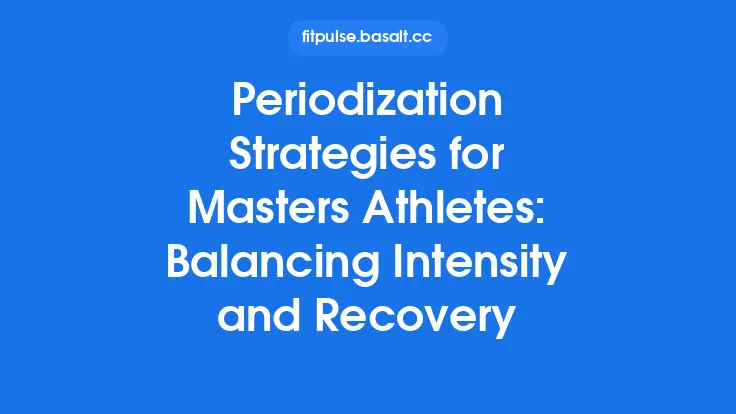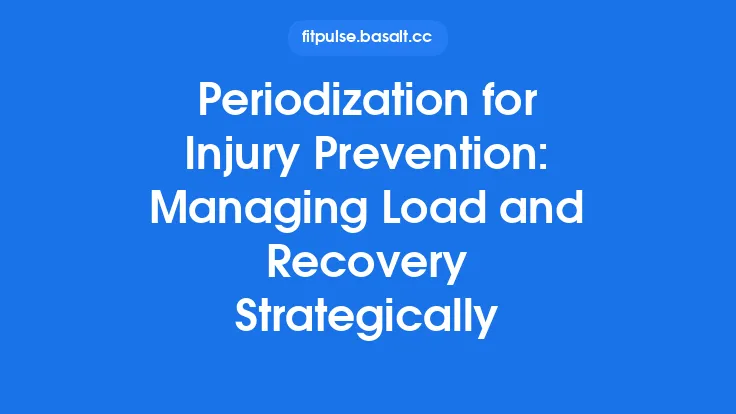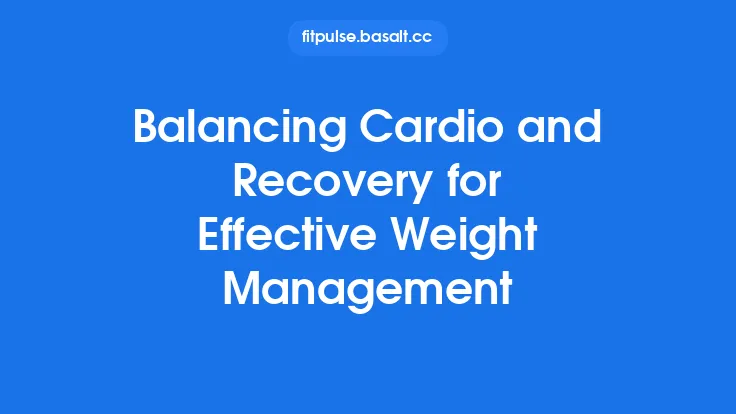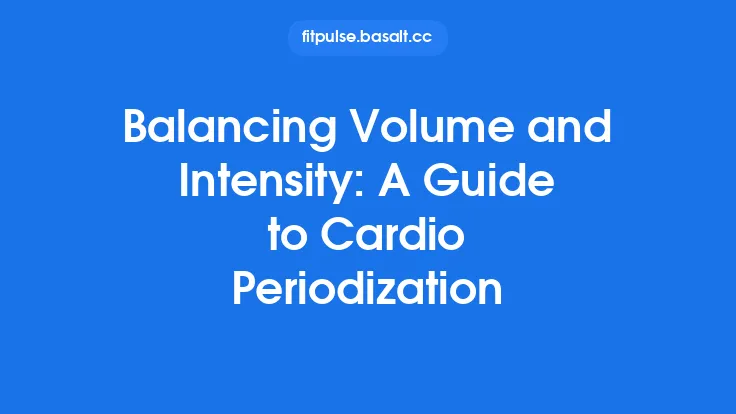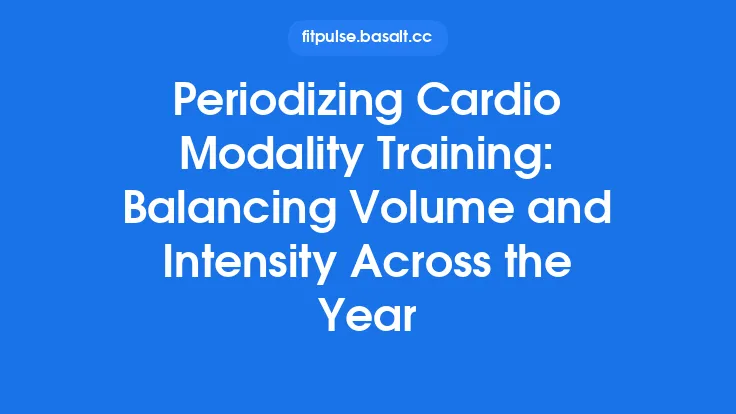The concept of periodization—systematically varying training variables such as volume, intensity, and frequency over time—has been a cornerstone of athletic preparation for decades. Traditional periodization models rely on the coach’s experience, athlete feedback, and periodic performance testing to decide when to push harder and when to pull back. While effective, these approaches are limited by the inherent lag between data collection, analysis, and program adjustment. In an era where athletes generate continuous streams of physiological, biomechanical, and contextual data, artificial intelligence (AI) offers a way to close that loop, delivering truly intelligent periodization that balances progression with recovery on an individual basis.
AI’s role in periodization is not about replacing the human coach but augmenting decision‑making with predictive analytics, pattern recognition, and adaptive optimization. By ingesting high‑frequency data—from heart‑rate variability (HRV) and sleep architecture to muscle oxygen saturation and external load metrics—AI systems can model an athlete’s fatigue‑recovery continuum in near real‑time. This enables the creation of training plans that evolve day‑by‑day, ensuring that each session contributes to long‑term performance goals while minimizing the risk of overreaching or injury.
Understanding Periodization: The Foundations of Structured Training
Periodization is built on three hierarchical layers:
| Layer | Typical Duration | Primary Focus |
|---|---|---|
| Macrocycle | 6–12 months | Overall performance objectives (e.g., peak for a championship) |
| Mesocycle | 3–6 weeks | Specific physiological adaptations (e.g., hypertrophy, strength, endurance) |
| Microcycle | 1 week | Tactical session planning, recovery days, and load distribution |
Each layer traditionally follows a linear, undulating, or block pattern, with predetermined “hard” and “easy” phases. The challenge lies in translating population‑based templates into individualized schedules that respect each athlete’s unique response to stress.
The Science of Progression and Recovery: Why Balance Matters
Progression drives adaptation through the principle of supercompensation: a training stimulus creates fatigue, followed by a recovery window where the body rebuilds stronger. If the next stimulus arrives too early, accumulated fatigue impairs performance and raises injury risk. If it arrives too late, the adaptive window closes, and the training effect plateaus.
Key physiological markers that delineate this window include:
- Heart‑Rate Variability (HRV): Reflects autonomic balance; a drop often signals heightened sympathetic activity and insufficient recovery.
- Creatine Kinase (CK) Levels: Elevated CK indicates muscle damage; trends help gauge tissue repair.
- Sleep Architecture: Deep‑sleep proportion correlates with hormonal milieu (e.g., growth hormone) essential for tissue remodeling.
- Subjective Wellness Scores: Mood, perceived fatigue, and soreness provide a psychophysiological context.
Balancing progression and recovery therefore requires a dynamic assessment of these markers, something AI can perform continuously and at scale.
Data Streams that Power Intelligent Periodization
AI models thrive on diverse, high‑resolution data. The most informative streams for periodization include:
| Data Type | Source | Frequency | Relevance |
|---|---|---|---|
| External Load | GPS, power meters, bar‑path sensors | Per‑rep / per‑session | Quantifies mechanical stress |
| Internal Load | HR, HRV, lactate sensors | Continuous | Captures physiological strain |
| Recovery Metrics | Wearable sleep trackers, HRV monitors | Nightly | Indicates readiness |
| Biomechanical Signals | Inertial measurement units (IMUs) on joints | Per‑movement | Detects technique fatigue |
| Contextual Variables | Training logs, travel schedules, nutrition apps | Daily | Adjusts for non‑training stressors |
By fusing these streams into a unified data lake, AI can generate a multidimensional “readiness score” that informs the next training decision.
Modeling Fatigue and Adaptation: AI Techniques
Several AI methodologies have proven effective for fatigue‑recovery modeling:
- Recurrent Neural Networks (RNNs) & Long Short‑Term Memory (LSTM) Models
- Capture temporal dependencies in sequential data (e.g., HRV trends over weeks).
- Predict future readiness based on past patterns.
- Bayesian Hierarchical Models
- Incorporate prior knowledge (e.g., known population response curves) while allowing individual deviations.
- Provide probabilistic confidence intervals for predicted performance.
- Gaussian Process Regression (GPR)
- Offers smooth, non‑parametric fitting of complex, noisy physiological data.
- Useful for estimating the optimal “training impulse” (TRIMP) that maximizes adaptation.
- Reinforcement Learning (RL) Agents
- Treat periodization as a sequential decision problem where the agent selects training loads to maximize a cumulative reward (e.g., performance gain) while penalizing excessive fatigue.
- The agent learns policies that balance exploration (trying new load patterns) and exploitation (using proven effective cycles).
These techniques can be combined in ensemble models to improve robustness and interpretability.
Adaptive Macro‑ and Micro‑Cycles: How AI Re‑Shapes the Calendar
Instead of a static 4‑week mesocycle, AI can generate fluid cycles that expand or contract based on real‑time readiness:
- Dynamic Mesocycle Length: If the readiness score remains high for three consecutive weeks, the AI may extend the high‑intensity block, capitalizing on the athlete’s favorable state. Conversely, a sudden dip triggers an early transition to a recovery block.
- Microcycle Load Redistribution: Within a week, the AI can shift volume from a Monday session to a Thursday session if the athlete’s morning HRV indicates lingering fatigue.
- Auto‑Tapering Algorithms: As a competition date approaches, the AI gradually reduces cumulative load while preserving intensity, guided by a tapering model calibrated to the athlete’s historical taper response.
The result is a personalized periodization map that retains the strategic intent of traditional periodization (e.g., peaking) but executes it with day‑level precision.
Real‑Time Load Adjustment: From Prediction to Execution
The transition from AI recommendation to on‑field execution hinges on two components:
- Decision Engine – A lightweight inference module running on a mobile device or smartwatch evaluates the latest sensor inputs and outputs a load prescription (e.g., “perform 4 sets of 6 reps at 80 % 1RM, reduce volume by 15 %”).
- Feedback Loop – The athlete’s immediate physiological response (e.g., post‑set HRV, muscle oxygen saturation) is streamed back to the cloud, allowing the model to confirm or adjust the prescription within the same session.
This closed loop enables intra‑session periodization, where the plan can be tweaked after the first set based on real‑time fatigue signals, a capability previously limited to elite labs.
Integrating Wearable Sensors and Cloud Analytics
A practical AI‑driven periodization system typically follows this architecture:
- Edge Layer (Wearables): Sensors collect raw data (accelerometry, ECG, SpO₂) and perform preliminary preprocessing (e.g., artifact removal).
- Transmission Layer: Secure Bluetooth Low Energy (BLE) or Wi‑Fi transfers data to a smartphone gateway.
- Cloud Layer: Scalable compute resources host the AI models, perform feature extraction (e.g., time‑frequency HRV analysis), and store longitudinal data.
- Presentation Layer: A user‑friendly dashboard displays readiness scores, upcoming training prescriptions, and historical trends. Coaches can override or fine‑tune recommendations, preserving the human element.
Key technical considerations include:
- Latency: For intra‑session adjustments, end‑to‑end latency must stay under 5 seconds.
- Data Integrity: Redundant buffering on the device prevents loss during connectivity gaps.
- Scalability: Containerized micro‑services (e.g., Docker + Kubernetes) allow the system to serve dozens of athletes simultaneously.
Case Study: AI‑Guided Periodization in Endurance Athletes
Background: A national‑level distance runner (female, 28 y) experienced performance plateaus despite a conventional 12‑week block periodization plan.
Implementation:
- Data Capture: HRV (nightly), sleep stages (actigraphy), GPS‑derived training load, and muscle oxygen saturation (NIRS) during key long runs.
- Modeling: An LSTM network trained on the athlete’s 18‑month history predicted a 7‑day readiness horizon.
- Intervention: The AI suggested a 3‑day micro‑recovery block after a high‑intensity interval week, followed by a 4‑day progressive overload phase.
Results (8‑week window):
| Metric | Pre‑AI | Post‑AI | % Change |
|---|---|---|---|
| VO₂max (ml·kg⁻¹·min⁻¹) | 58.2 | 60.5 | +3.9 % |
| Time‑to‑Exhaustion (km) | 18.0 | 19.6 | +8.9 % |
| Average Nightly HRV (ms) | 45 | 52 | +15.6 % |
| Self‑Reported Fatigue (1‑10) | 6.2 | 4.1 | –33 % |
The athlete reported feeling “more in control” of training stress, and the coach noted a smoother progression toward the target race.
Practical Implementation for Coaches and Athletes
- Start Small: Begin with a limited sensor suite (e.g., HRV strap + GPS watch) to avoid data overload.
- Define Clear Objectives: Whether the goal is peak performance, injury prevention, or long‑term health, the AI’s reward function must reflect that priority.
- Establish Baselines: Collect at least 4 weeks of “normal” training data to calibrate the model’s fatigue‑recovery curves.
- Maintain Human Oversight: Use the AI’s recommendations as a decision aid; coaches should validate any drastic load changes.
- Iterate and Refine: Periodically retrain models with new data to capture evolving physiological adaptations.
Limitations, Risks, and Future Directions
- Data Quality: Inaccurate sensor readings (e.g., motion artifacts in HRV) can mislead the model. Robust preprocessing and outlier detection are essential.
- Individual Variability: Some athletes exhibit non‑linear or delayed responses to training; models must incorporate uncertainty quantification to avoid over‑confidence.
- Ethical Use of Data: While privacy is outside the scope of this article, transparent data handling policies remain a prerequisite for adoption.
- Integration with Other Coaching Tools: Future platforms may combine periodization AI with nutrition planning, mental‑skill coaching, and injury‑risk analytics for a holistic performance ecosystem.
- Explainability: As deep learning models become more prevalent, developing interpretable visualizations (e.g., feature importance heatmaps) will help coaches trust AI recommendations.
Looking ahead, advances in multimodal sensor fusion, federated learning (allowing model improvement without sharing raw data), and real‑time biomechanical feedback promise even tighter coupling between training stimulus and physiological response. Intelligent periodization, powered by AI, is poised to become the new standard for athletes seeking to maximize gains while safeguarding health.
